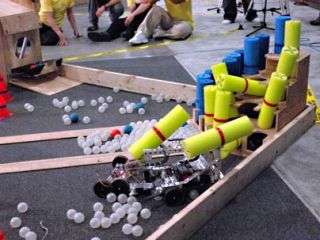Beaver-like robots face off in annual MIT contest

Robots designed to toss pool-noodle trees into a river of ping-pong balls ruled over competitors focused on rescuing fuzzy toy beavers in this year's 2.007 contest, "Da (yes) MIT, or Save the Baby Beavers," held on Thursday, May 8, in the Johnson Athletic Center at MIT.
The student machines were designed and built for the MIT mechanical engineering course, Introduction to Design and Manufacturing. Each was required to perform beaver-like tasks--knocking down trees, gathering food in the form of street hockey balls--while warding off competitors in 45-second rounds. Contestants used PlayStation controllers to drive their autonomous 'bots.
The top four 2.007 winners are all sophomores in mechanical engineering. Gregory Tao used the tree-toss strategy to win the contest, defeating Ethan Huwe in the final rounds of the two-night adventure in extreme engineering.
Aaron Ramirez, a persistent high scorer, came in third in the contest yet triumphed in couture: He wore an Iron Man suit made of blue foamies, a snap-together toy, for the evening. Radu Gogoana took fourth place.
All will travel to Brazil this summer to participate in the annual International Design Contest, a global version of MIT's 2.007 in which students from different countries form engineering design teams and build robots.
Alexander Slocum, professor of mechanical engineering, emceed the event, mixing his signature auctioneer's patter with a message about why the contest and MIT students' excitement about hands-on engineering is so important.
"MIT is the world university, and when kids work together this way I know there's hope. This is what the future of the planet is about--experimenting, testing, failing and playing with ideas. That's how learning takes place," he said. "That's how deep geek-dom turns into cool technology."
Slocum, who has run the 2.007 contest and taught the Introduction to Design course for more than a decade, added energy-awareness as an engineering principle this year, he said.
Notably absent were the massive plywood and lumber contest tables of previous years. The robots now run on the floor, saving wood and other materials.
"This is our first attempt to do a green contest. We've saved materials by using the floor, and other MIT programs like MITES and the Edgerton Center will use the scoring furniture. Everything is recycled," Slocum said.
Yet the spirit of invention prevails. As Slocum put in his wrap-up of 2.007 for 2008, "The machines, the students, it's all geek-alicious. It's geek-aliciously manufacturistic robustification."
Source: MIT





















